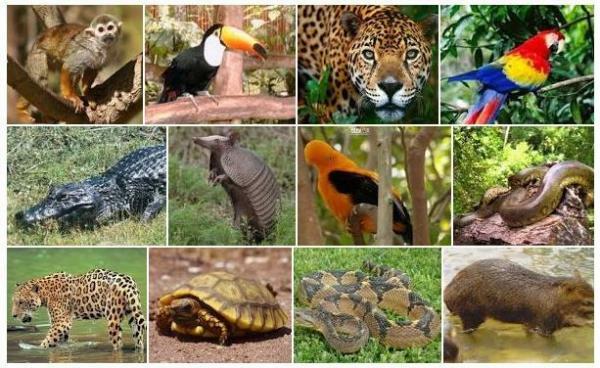What are the ANIMALS of the jungle
The jungle animals They may be carnivores, herbivores and omnivores. Among the animals that we can find in the different forests of our planet are the following.
Harpy eagle (Harpia harpyja)
The harpy eagle is the strongest bird of prey in the world and the largest in the American continent and the second in the world. It lives in the tropical jungles of Central and South America. It has long and muscular claws and feeds on arboreal mammals such as monkeys, sloths or porcupines, but also on snakes, pigs or small birds.
Anaconda (Eunectes murinus)
The anaconda or water boa is the largest snake in the world and lives in the tropics of South America, where it lives in tropical jungles, on the banks of the Orinoco River or in the Amazon. The anaconda is a carnivorous species, but it is not poisonous but constrictive, coiling itself around the body of its prey until it stops breathing, then they dive into the water and swallow them whole. Despite this, it is harmless to humans and only attacks in self-defense.
Armadillo (family Dasypodidae)
The armadillo is another of the jungle animals. A placental mammal that lives in the jungles of Central and South America. Tatú, quirquincho, peludo, toche or mulita, are some of the popular names given to it in the different countries where it is found. The armadillo is an animal that is characterized by being completely covered in armor and having long claws. It is an excellent nocturnal burrower that feeds on insects.
Orinoco Cayman (Crocodylus intermedius)
The Orinoco caiman is one of the largest crocodile species in the world (reaching up to seven meters) endemic to the Orinoco basin. They are super-predators (their only predator is man), feeding on frogs, snakes, birds or mammals, although they prefer a piscivorous diet.
Chimpanzee (Pan troglodytes)
The chimpanzee is a placental mammal that lives in the jungles of West Africa. It feeds on invertebrate animals, leaves, fruits and nuts, but it can also hunt large animals such as birds or pigs. Chimpanzens are highly intelligent animals that share up to 99% of the genome with human beings. humans, also form hierarchical societies and can use tools to dig wells or other activities.
Indian elephant (Elephas maximus indicus)
The Indian elephant is one of the four subspecies of Asian elephants that exist today, they inhabit Asian rainforests (among other habitats). Elephants are mega-herbivores, consuming up to 150 kilos of herbs, leaves, roots, bark or stems per day. They have a very long gestation, between 18 and 22 months, and can give birth to two young that weigh up to 90 kg.
Gorilla (Gorilla spp.)
The gorilla is another of the jungle animals and one of the largest primates that inhabit the African jungle. They are animals that can weigh up to 200 kilos and reach a height of 175 centimeters. Despite their strong and muscular build, they are herbivorous animals, which feed on fruits, leaves, shoots or insects.
These animals usually move on all fours, with the forelimbs much longer than the hindlimbs. Gorilla gestation lasts similar to that of humans, nine months, and they can spend up to four years between gestations, since the calf is quite dependent the first years of its life.
Macaw (Ara spp.)
These talking birds of the psittaform family and which stand out for their striking colors, inhabit the tropical jungles of the world. It is a diurnal bird, very social (it forms flocks of several individuals) and feeds mainly on seeds. Macaws only reproduce from the age of four and lay about four eggs per season.
Hippopotamus (Hippopotamus amphibius)
This is one of the largest mammals that inhabits the jungles of West Africa and there are two species, the common hippo and the pygmy hippo (Choeropsis liberiensis). It is a large animal with short legs, a round, thick body and a large head. Adults are very territorial, living in groups of up to thirty females. They are mainly herbivorous animals, their main food is grass, but they have also been seen eating carrion or predating.
Leafcutter ant (genera Atta and Acromyrmex)
These ants (in fact 47 species are grouped under this name) inhabit the jungles of America and form really complex societies. They can build underground nests up to 30 meters wide and with surfaces of up to 600 square meters that allow up to 8 million ants to live. Colony of these ants usually develop from flying females that mate with several males and lay hundreds of eggs.
Jaguar (Panthera onca)
It is a feline animal that is related to the leopard and inhabits the dense jungles of Central and South America, as well as plains, valleys and forests. An adult jaguar can reach up to 1.85 in length and a height between 70 and 90 centimeters.
Jaguars are great climbers, swimmers and ferocious predators that hunt at night, as they have great night vision. They have a gestation of about one hundred days and can have from one to four cubs per litter, which are raised by their mother, who has to defend them even from her own father.
Lemur (Lemur catta)
The lemur is another of the jungle animals; a species of primate, with the ring-tailed lemur as the only species of the genus lemur, which inhabits the jungles of Madagascar. It is an omnivorous animal, with diurnal habits and mostly terrestrial. They are very social animals, living in groups of up to thirty individuals, where the male maintains his hierarchy with respect to the female. They are primates that use numerous vocalizations, as signals of cohesion in the group and alarm.
Leopard (Panthera pardus)
The leopard is one of the largest cats that inhabit the world, and they can live in a large number of ecosystems, such as forests and jungles. Leopards have a modification of the hyoid bones, in the jaw, that allows them to roar.
These big cats are excellent nocturnal hunters, with retractable claws for this purpose, and they sleep during the day. They are normally solitary animals, except in the reproductive season, in which they can give birth to up to six cubs in the same litter.
Spider monkey (Ateles spp.)
Spider monkeys are called those monkeys from America with long limbs and a prehensile tail that allow them to swing and jump from tree to tree with extreme agility. They inhabit tropical jungles in South America, some species at high altitude (7 species are known). They are herbivorous animals, feeding mainly on fruits and nuts.
Vampire bat
Under the denomination of vampires, several species of chiroptera are grouped, all inhabitants of the American continent, where they live in jungles (among other locations). Vampires are hematophagous, that is, they feed specifically on the blood of other mammals, which they make a small cut to suck their blood. They have an extraordinary system of localization through sounds and hearing, since they do not have developed eyesight and live in very dark environments.
Orangutan (I put spp.)
Orangutans are primates that inhabit tropical rainforests, where they live in the tops of the Trees most of the time, even live suspended, helped by the great span of their arms. These primates are closely related to humans and are really smart. They feed on fruits, tree leaves, bark and insects, and very rarely eat meat. Female orangutan only give birth every eight years and care for their young for seven to eight years, until they learn survival techniques.
Lazy (Choloepus didactylus)
The two-toed sloth is the largest sloth in the world and lives in the Amazon rainforest. It is a solitary, diurnal animal that lives in the treetops, feeding on leaves and fruits.
Piranhas
Under the name of piranhas, different families of voracious fish are grouped, usually carnivores, although in their juvenile stages they can be omnivores. Piranhas live in warm or warm fresh waters, almost exclusively in Central and South America. The Amazon rainforest is the place with the highest concentration of piranhas in the world.
Royal python (Python regius)
It is an African snake that lives in the jungle, also known as a ball python because of its shyness, since it curls up like a ball. It is a carnivorous predator that hunts at night, since it is perfectly adapted for it, feeding mainly on rodents, but also on birds or reptiles. Given its calm nature, many people have it as a pet, which is why it is becoming an invasive species in some areas (such as Spain).
Cougar (Puma concolor)
The puma is a large carnivorous feline that inhabits a large number of biomes in the Americas, including the jungles of South America. This animal is solitary and incapable of roaring, unlike other felines.
Red-eyed frogAgalychnis callidryas)
This tree frog lives in tropical jungles in central and southern America. They are nocturnal (non-poisonous) carnivores that feed on insects, crickets, lobsters, moths, or flies. These frogs are in danger of extinction due to the destruction of their habitats.
Tapir (Tapirus spp.)
Tapirs are perissodactyl mammals (odd-toed ungulates) that inhabit humid jungles, such as the Amazon or jungles of various Asian countries. They are medium-sized animals, reaching lengths from 1.3 meters to 2.5 meters, heights of up to 1.2 meters and weighing up to 300 kilos. They usually feed on roots, leaves and herbs.
Tarantula (Lycosa spp.)
Under the name of tarantulas we find several genera of the largest spiders in the world, which inhabit various jungles in South America. They feed primarily on insects, grasshoppers, cockroaches, and sometimes rodents. Food rich in proteins, which they need to maintain their coat.
Tiger (Panthera tigris)
The tiger is one of the most iconic big cats in the world and is found in very diverse habitats, including rainforests and savannas. Nine subspecies of tigers are known in the world, three of them have become extinct, such as the Bengal tiger (the most numerous) or the Indochina tiger. The largest tigers can weigh up to 300 kg and are solitary animals, except for mothers and cubs. Tigers are super predators, although they are highly threatened by human action.
Toucan (Ramphastus spp)
We end this review of the jungle animals talking about toucans, birds that inhabit the tropical jungles of South America. Toucans have a long beak for feeding and defense. They feed on fruits and insects and sometimes small birds, lizards or eggs.




